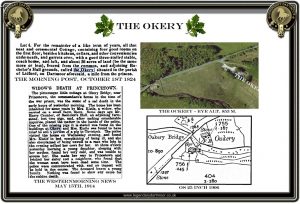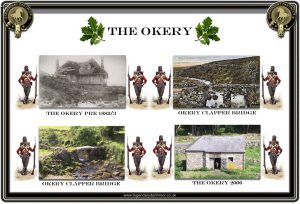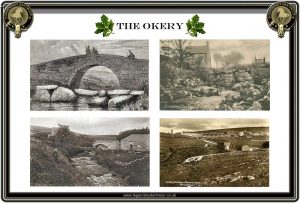
I would wager a months salary that thousands of people have driven or walked over the modern bridge that carries the B3212 over the Blackabrook just to the north east of Princetown and not even noticed the little building now called the ‘Okery’. And why should they, afterall it looks just like a recently restored barn, which in a way it is. When passing here the attention is easily diverted to the famous Dartmoor Prison on the opposite side of the road. But this little building holds a great deal of history and sadly doesn’t give an inkling of its past.
The original building was built sometime in the early 1800’s (probably around 1805) by Thomas Tyrwhitt who was the lessee of the Tor Royal Estate. In 1818 Tyrwhitt successfully managed to grow an acreage of flax and according to Trevor James he established a flax mill at the Okery. p.17. It is possible that the Ockery was also used as a cottage to be used by the miller of the nearby Bachelor’s Hall Mill and that it appears in the 1841 census as Bachelor’s Hall Cottage.
Following the fashionable trend for the ‘picturesque’ it was built in the ‘Swiss Style’ of the time. The building was a small, square, three storey, thatched structure with walls built of granite. The upper portion of the house was faced with hanging slates and the first floor exterior was surrounded by a wooden veranda thus giving it the ‘Swiss style’. The ground floor consisted of a kitchen and another room, stairs then led up to the first floor which comprised of two bedrooms and a store cupboard, one of the bedrooms contained the door which lead out onto the veranda. There was also a second thatched building that originally served as a coach house and stable, this was constructed in 1808, in later years this was used as a ‘turf house’. By 1812 The Ockery had a large one-roomed extension added, this effectively added an additional, self contained dwelling unit to the original building. In 1882/3 The Ockery underwent extensive repairs which in effect led to the demolition of the 1812 extension and the removal of the veranda. At that time a Duchy ruling stated that all their housing stock should have three bedrooms which meant The Ockery had a third bedroom constructed under the roof. As can be seen from below, in 1824 The Ockery lease was being advertised and according to that the property was described as being a “neat and ornamental cottage,” comprising of four rooms on the first floor, with kitchens, cellars etc. underneath, a garret above, a three-stored stable, coach house, a loft along with 36 acres of land.
After standing derelict from around 1915 The Ockery was finally demolished in 1925 leaving just the old barn standing. This was later repaired and is the building that can be seen today. It is now used as a horse stable as can be seen from the photograph below. It is not until 1822 that the first mention of ‘The Ockery’ appears for certain, in this case it is noted in the baptismal register of Princetown that, ‘Richard Gerry and his wife Agnes had their son baptised”. From 1841 to 1915 there were a whole succession of tenants residing at The Ockery whose occupations varied from stonemasons, agricultural workers, and sextants.
In the late 1890’s one such tenant living at The Ockery was James Kistle who was a quarry worker at Foggintor and in his spare time farmed the 4 acre field that was part of the property for bullock rearing. He married a woman called Clara and they ended up with eleven children of which eight survived. James Kistle died in 1912 leaving Clara to bring up the children and continue with the small farm. In 1914 one of Clara’s neighbours, Henry Caunter from Bachelor’s Hall lost two pigs, after a desperate and fruitless search for the animals he reported the loss to the Tavistock police. They conducted their own enquiries and found one of the missing pigs in the barn of The Ockery. After obtaining a search warrant on the 12th of May the police conducted a search of Clara’s home but found no further evidence. Later that day it was reported that she had been seen at Tavistock market attempting to sell some pork meat. The following morning she wrote a letter to another neighbour, Mr Coaker who lived at Sherberton Farm, it read; “Dear Mr Coaker, Will you be as kind as to come out as I am in great trouble. I have not a friend in the world, and have five children under the age of 14 to keep. It is about Harry Caunter’s pigs. I will give anything if you come out; you told me you would any time I was in trouble. C. Kistle P.S. Come out this morning“. This letter never reached farmer Coaker and Clara Kistle was found dead in bed on the morning of the 14th of May by her 13 year old daughter Nellie. The following inquest was unable to establish the cause of Clara’s death but subsequent searches of her house revealed a packet of arsenic. A postmortem was held where quantities of the poison where found in her body, the coroner and jury duly arrived at the conclusion that Clara had committed, “suicide while temporarily insane”. The Kistle children were allowed to stay rent-free at the cottage until places could be found for them at a workhouse or orphanage. Nobody ever lived at The Ockery again and as noted above the building was demolished in 1925.
There has always been a great debate regarding another tradition of the Ockery and that is during the Napoleonic Wars, one or two French prisoners of war stayed here. These were supposedly two Generals called Rochambeau and Boyé, both parolees. Tradition has it that one of them was told that Napoleon was about to land in England and on hearing the news he donned his full dress uniform and began marching up and down the building waiting to greet his emperor. But at best it is now believed that the two Generals may have stayed at The Ockery overnight in 1811 as they made their way to Plymouth for repatriation.
The small clapper bridge that stands beside The Ockery was at one time the original pack-horse bridge that took the road into Princetown. Most of the early topographical writers have very little to say about this clapper as it appears the larger more impressive ones at Two Bridges and Postbridge have drawn their attention. Page, for example, simply says: “With the exception of a picturesque old ‘clapper’ bridge with two openings, just below the more modern structure spanning the Blackabrook, known as the Ockerry Bridge, there is little to attract attention.” The modern bridge that now carries the road was according to Crossing called Trena Bridge and was constructed in 1901, p.111, however, it’s interesting to see that on the OS maps have for a long time called it ‘Oakery Bridge’. Could this be initially down to someone getting confused with the local dialect and interpreting ‘Okery’ for ‘Oakery’?
However, one claim to fame that the old clapper with two openings has is that once a local woman actually caught a piskie which she met here on her way home, not many bridges can boast about that!

Crossing, W. 1989 Princetown – its rise and progress, Quay Publications, Brixham. p. 59.
James, T. 2013. Prisoners of War at Dartmoor. London: McFarlane & Company
Stanbrook, E. 1994 Dartmoor Forest Farms, Devon Books, Exeter. pp 66 – 77.
 Legendary Dartmoor The many aspects past and present of Dartmoor
Legendary Dartmoor The many aspects past and present of Dartmoor




2 comments
Pingback: Trans-Dartmoor Packhorse Track: Part 4 – Princetown to Two Bridges – A Walk in English Weather
Pingback: Trena / Oakery Bridge – Dartmoor Explorations